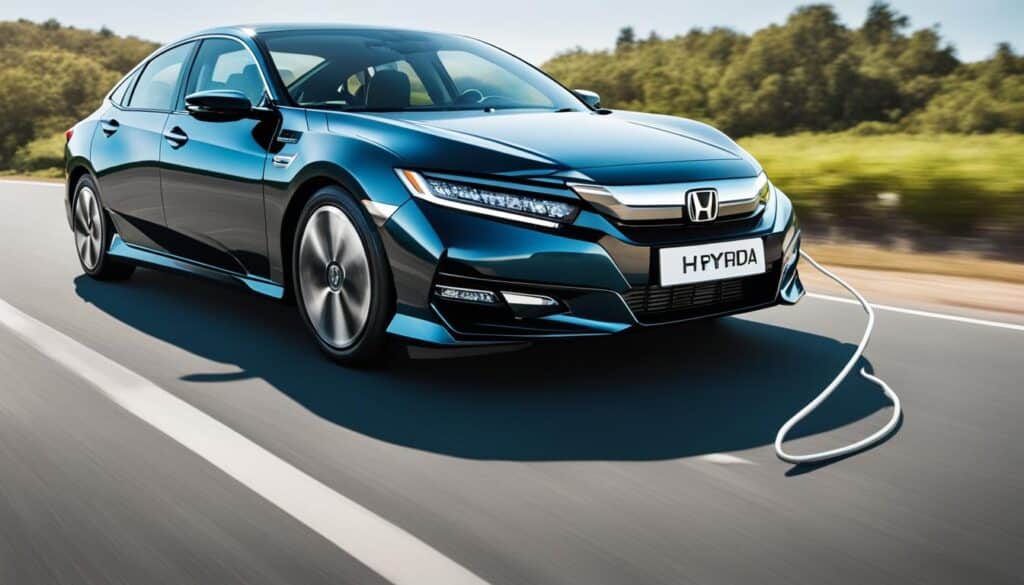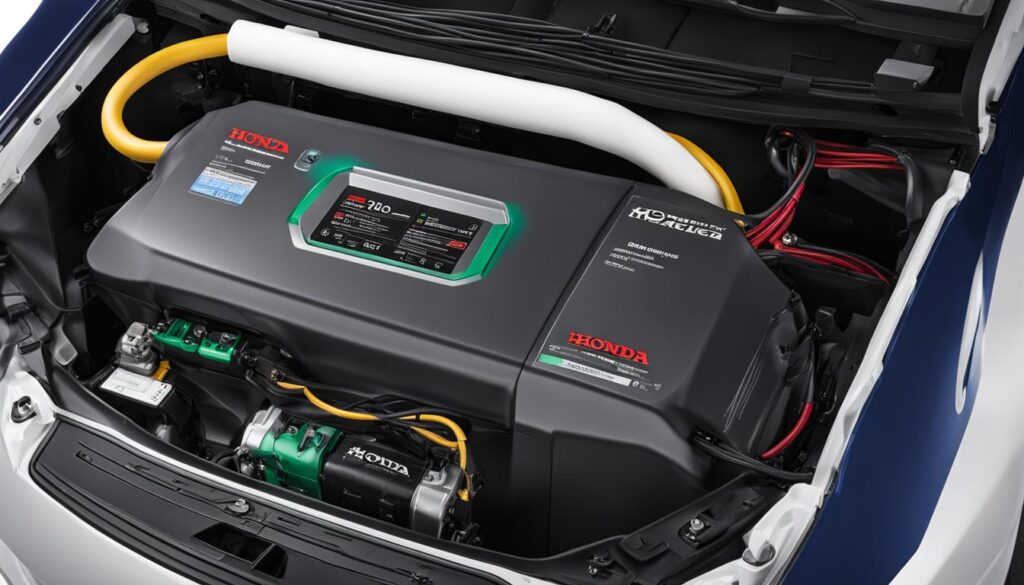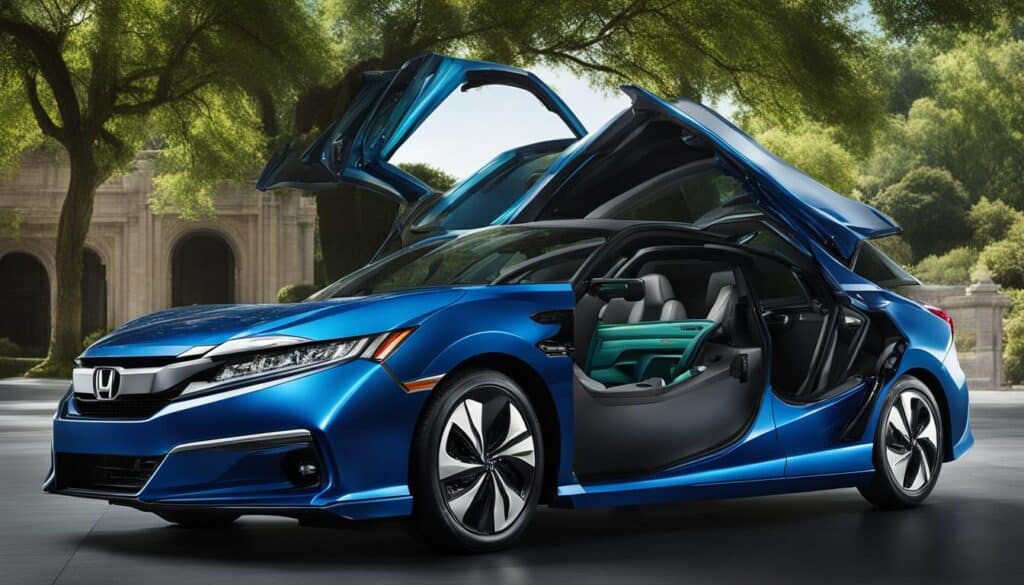I’m excited to introduce you to the fascinating world of Honda hybrid technology. In this article, we will explore the working principle of Honda hybrid cars and delve into the innovative technology that powers them.
Honda hybrids are designed to combine the best of both worlds: the efficiency of an electric motor and the power of a combustion engine. This harmonious integration allows the two power sources to work together or independently, resulting in improved fuel efficiency and reduced emissions.
When you drive a Honda hybrid, you’ll experience the seamless transition between electric and gasoline-powered modes. Let’s take a closer look at the different types of Honda hybrid systems and how they operate.
Key Takeaways:
- Honda hybrids combine an electric motor and a combustion engine for improved fuel efficiency and reduced emissions.
- There are three main types of Honda hybrid systems: mild hybrid, full hybrid, and plug-in hybrid.
- Mild hybrids assist the combustion engine with the electric battery, offering some fuel economy benefits.
- Honda hybrids are self-charging, utilizing energy generated by the combustion engine and regenerative braking for battery replenishment.
- Hybrids achieve better fuel economy and lower emissions compared to conventional cars.
Now that we’ve covered the basics of how Honda hybrid works, it’s time to dive deeper into each type of hybrid system. Stay tuned for the next section, where we will explore the unique characteristics and benefits of mild, full, and plug-in hybrids.
Types of Honda Hybrid Systems
Honda offers a range of hybrid systems tailored to different needs and preferences. Let’s explore the three main types of Honda hybrid systems: mild hybrid (MHEV), full hybrid (FHEV), and plug-in hybrid (PHEV).
Mild Hybrid (MHEV)
Mild hybrids feature a powerful electric battery that assists the combustion engine, particularly during acceleration. This electric battery provides an extra boost of power, enhancing the overall performance of the vehicle. The battery is recharged through regenerative braking, a process that captures and utilizes energy that would otherwise be wasted during braking. While mild hybrids offer some fuel economy benefits, their fuel efficiency and emissions are not as impressive as other types of hybrids.
Full Hybrid (FHEV)
Full hybrids, also known as self-charging hybrids, combine the power of an electric motor and a combustion engine. These hybrids can operate using either the electric motor alone, the combustion engine alone, or a combination of both, depending on driving conditions and power demands. The batteries in full hybrids are charged using energy generated by the combustion engine, eliminating the need to plug them in for charging. This self-charging capability offers convenience and eliminates range anxiety. Full hybrids provide better fuel economy and lower emissions compared to conventional cars.
Plug-in Hybrid (PHEV)
Plug-in hybrids offer the most advanced hybrid technology available. They have a larger battery capacity than mild and full hybrids, allowing for extended all-electric driving range. Plug-in hybrids can be charged by plugging them into an electrical outlet, providing the ability to drive on electric power alone for a significant distance. When the electric charge is depleted, the vehicle seamlessly switches to the combustion engine, providing additional range and flexibility. Plug-in hybrids combine the benefits of electric vehicles and hybrid technology, offering improved fuel economy and reduced emissions.
| Type | Main Features | Fuel Efficiency | Emissions |
|---|---|---|---|
| Mild Hybrid (MHEV) | Assists the combustion engine, regenerative braking | Offers some fuel economy benefits | Not as impressive as other hybrids |
| Full Hybrid (FHEV) | Combines electric motor and combustion engine, self-charging | Better fuel economy compared to conventional cars | Lower emissions than conventional cars |
| Plug-in Hybrid (PHEV) | Bigger battery capacity, extended all-electric range | Improved fuel economy | Reduced emissions |
Each type of Honda hybrid system offers unique characteristics and benefits, catering to different driving preferences and requirements. Whether you prioritize fuel efficiency, reduced emissions, or extended all-electric range, Honda has a hybrid solution to meet your needs.
How a Honda Hybrid Charges Itself
In Honda hybrids, both mild and full, the charging process is handled internally, eliminating the need for external power sources. These self-charging hybrids efficiently utilize the energy generated by the combustion engine to charge their batteries, ensuring they are always ready for the next drive.
A key feature contributing to the self-charging capability is regenerative braking. When the driver applies the brakes, the hybrid system converts the car’s kinetic energy into electrical energy. This captured energy is then directed to the battery, effectively recharging it without the need for external power resources.
This innovative system provides several benefits. First, it eliminates the need for finding or installing charging stations, as the hybrids can recharge themselves during regular driving conditions. This convenience makes Honda hybrids a practical choice for everyday use.
“Honda hybrids are designed to optimize every possible opportunity to charge the battery. Whether it’s through regenerative braking or leveraging the engine’s power, the self-charging capability ensures that the battery is always ready for the driver’s next journey.”
The self-charging design also eliminates the concern of range anxiety commonly associated with fully electric vehicles. Honda hybrids provide peace of mind, knowing that the driving experience isn’t limited by the availability of charging infrastructure.
Overall, the self-charging feature in Honda hybrids, powered by regenerative braking and internal combustion engine energy, offers convenience, reliability, and a seamless driving experience without compromising efficiency.

Self-Charging Hybrid Benefits:
- No need to plug in for charging, eliminating the need for finding or installing charging stations.
- Regenerative braking converts kinetic energy into electrical energy, helping recharge the battery.
- Freedom from range anxiety, as the self-charging mechanism ensures the battery is always ready for the next journey.
- Convenience and reliability for everyday use.
- A seamless driving experience that does not compromise fuel efficiency.
| Hybrid Feature | Mild Hybrid | Full Hybrid |
|---|---|---|
| Charging Method | Self-charging through regenerative braking and engine power | Self-charging through regenerative braking and engine power |
| Availability of Plug-in Charging | No | No |
| Electric Motor Power | Assists combustion engine during acceleration | Provides short-range electric-only driving capabilities |
| Fuel Efficiency | Offers modest fuel economy improvement | Provides significant fuel efficiency benefits |
Differences Between Hybrids and Conventional Cars
When comparing hybrids and conventional cars, one of the key distinctions lies in the use of electric power. Unlike conventional cars that solely rely on a combustion engine, hybrids harness the power of an electric motor in addition to the engine. This integration of electric power allows hybrids to achieve greater fuel economy and lower emissions, making them a more sustainable option for environmentally conscious drivers.
Hybrids come in different types, such as mild hybrids and full hybrids, each with its own approach to utilizing electric power. Mild hybrids use the electric motor to assist the combustion engine, particularly during acceleration, enhancing performance while still relying primarily on the engine. On the other hand, full hybrids have the capability to power the vehicle for short distances solely using the electric motor, reducing dependence on the engine during low-speed city driving.
The utilization of electric power in hybrids not only improves fuel economy but also contributes to a reduction in emissions. By combining the power of an electric motor with a combustion engine, hybrids can optimize their energy usage and minimize wastage, resulting in a more efficient and environmentally friendly driving experience.
Hybrids offer the best of both worlds – the efficiency of an electric motor and the versatility of a combustion engine. This combination enables superior fuel economy and lower emissions, making hybrids a compelling choice for individuals seeking an environmentally responsible solution.
Differences Between Hybrids and Electric Vehicles (EVs)
When it comes to choosing between a hybrid and an electric vehicle (EV), understanding the key differences can help you make an informed decision. The main distinction between hybrids and EVs lies in their power sources.
Hybrids, like Honda hybrids, utilize a combination of an electric motor and a combustion engine. This dual power source allows hybrids to switch between using electricity and gasoline, offering flexibility and range. On the other hand, EVs solely rely on electricity as their power source, meaning they operate solely on battery power.
One notable advantage of hybrids is that they don’t suffer from “range anxiety,” a common concern for EV owners. Range anxiety refers to the fear of running out of battery charge and not having access to a charging station. Hybrid vehicles, with their combustion engine, can continue to run on gasoline even if the battery charge is low, alleviating range anxiety for drivers.
Another significant difference is the charging process. EVs require a mains electricity supply for charging, which can take several hours without a rapid charger. This has led to the development of an extensive EV charging infrastructure. In contrast, hybrids do not rely on external charging infrastructure. Instead, the battery in a hybrid is charged through regenerative braking and the combustion engine, eliminating the need for frequent charging stops.
In terms of battery technology, hybrids typically use advanced lithium-ion batteries, offering a balance between energy storage capacity and weight. These batteries can quickly absorb and store energy, making them ideal for hybrid vehicles. EVs, in comparison, often use larger batteries with higher energy storage capacity to power the vehicle for longer distances.
Overall, the choice between a hybrid and an EV depends on your specific needs and preferences. If you prioritize range flexibility and want to avoid range anxiety, a hybrid may be the better option. On the other hand, if you have access to charging infrastructure and are committed to reducing your carbon footprint, an EV might align more closely with your goals.
By understanding the differences between hybrids and EVs, you can choose the vehicle that best suits your lifestyle and transportation needs.
“The main difference between hybrids and electric vehicles lies in the power source. While hybrids use both an electric motor and a combustion engine, EVs solely rely on electricity. This brings key distinctions in terms of range flexibility, charging requirements, and battery technology.”
The Battery in a Honda Hybrid
In Honda hybrids, the heart of the powertrain lies in the hybrid battery, which is responsible for storing and delivering electrical energy. Honda utilizes advanced lithium-ion battery technology, known for its superior performance and efficiency.
The lithium-ion battery in a Honda hybrid is designed to absorb and store energy quickly, providing the necessary power to the electric motor when needed. This allows for seamless integration between the electric motor and the combustion engine, optimizing efficiency and reducing emissions.
Not all Honda hybrids are created equal when it comes to battery size. Full hybrids typically have larger batteries compared to mild hybrids, enabling them to provide more electric power and operate in electric-only mode for longer periods. On the other hand, plug-in hybrids have the largest and heaviest batteries due to their extended all-electric range.
The lifespan of a hybrid battery can vary depending on several factors, such as driving habits, climate conditions, and maintenance. However, Honda’s lithium-ion batteries are engineered for durability and longevity, offering a reliable power source for years to come.
To showcase the different battery sizes and capacities in Honda hybrids, here’s a detailed comparison:
| Hybrid Model | Battery Type | Battery Capacity |
|---|---|---|
| Honda Insight | Lithium-ion | 1.1 kWh |
| Honda Accord Hybrid | Lithium-ion | 1.3 kWh |
| Honda CR-V Hybrid | Lithium-ion | 1.5 kWh |
| Honda Clarity Plug-in Hybrid | Lithium-ion | 17 kWh |
This table provides a glimpse into the varying battery capacities across different Honda hybrid models, highlighting the larger size of the battery in plug-in hybrids for extended electric range.

With their efficient lithium-ion batteries and advanced hybrid technology, Honda hybrids offer both environmental benefits and a reliable driving experience. The battery lifespan ensures that hybrid owners can enjoy the benefits of increased fuel efficiency and reduced emissions for years to come.
Conclusion
In conclusion, Honda hybrids offer numerous benefits, making them a smart choice for eco-conscious drivers. One of the key advantages of Honda hybrid technology is its enhanced fuel efficiency. By combining the power of an electric motor and a combustion engine, Honda hybrids achieve better mileage and help drivers save on fuel costs.
Furthermore, Honda hybrids play a crucial role in reducing emissions and promoting a cleaner environment. Compared to conventional cars, Honda hybrids emit fewer pollutants, contributing to improved air quality and a healthier planet. With their advanced hybrid systems, Honda continues to lead the way in sustainable transportation solutions.
Whether you opt for a mild hybrid, full hybrid, or plug-in hybrid, each type offers specific electric power capabilities and recharging options. Honda’s commitment to innovation ensures that their hybrid technology keeps evolving, providing more sustainable and eco-friendly ways to travel.
FAQ
How does a Honda hybrid work?
A Honda hybrid combines the power of an electric motor and a combustion engine. These two power sources can work together or separately, resulting in lower exhaust emissions and increased fuel efficiency compared to conventional cars.
What are the types of Honda hybrid systems?
Honda offers three main types of hybrid systems: mild hybrid (MHEV), full hybrid (FHEV), and plug-in hybrid (PHEV). Each type has its own unique characteristics and benefits.
How does a Honda hybrid charge itself?
Honda hybrids are self-charging, meaning their batteries are charged using energy generated by the combustion engine. They also use regenerative braking, which converts kinetic energy into electrical energy to recharge the battery.
What are the differences between hybrids and conventional cars?
Hybrids use an electric motor to assist the combustion engine, resulting in better fuel economy and lower emissions. In contrast, conventional cars solely rely on a combustion engine for power.
What are the differences between hybrids and electric vehicles (EVs)?
Hybrids use both an electric motor and a combustion engine, while EVs are solely powered by electricity. Unlike EVs, hybrids do not require a mains electricity supply for charging and can operate without range anxiety.
What is the battery used in a Honda hybrid?
Honda hybrids use lithium-ion batteries, which are designed to quickly absorb and store energy. Full hybrids have larger batteries than mild hybrids, while plug-in hybrids have the largest and heaviest batteries due to their extended all-electric range.




